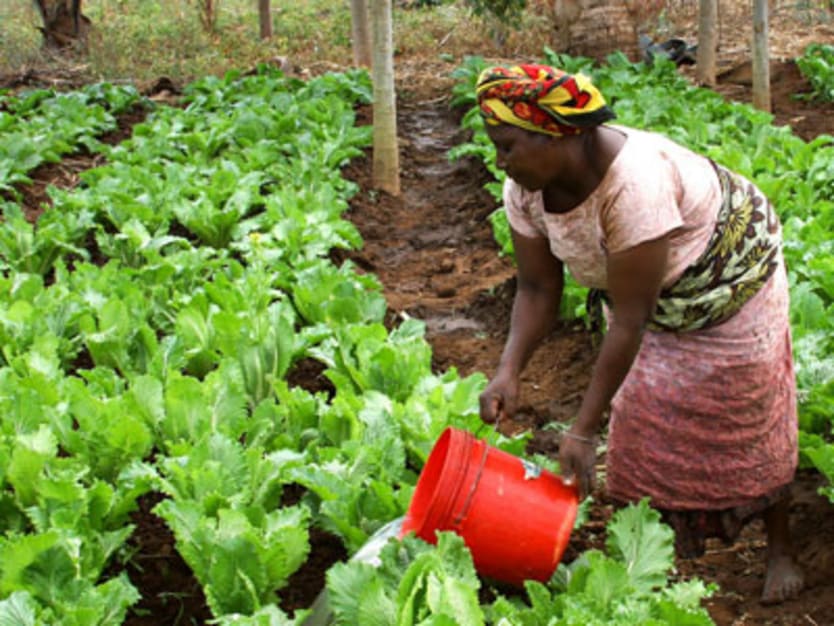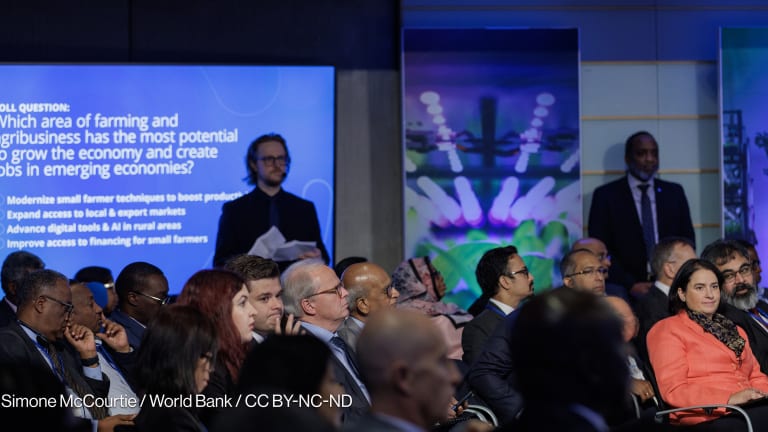
A revolutionary partnership between smallholder farmers and private companies, or a Faustian bargain that will benefit only multinational groups?
One year after the launch of the New Alliance for Food Security and Nutrition at the G-8 Summit in Camp David, which endorsed once and for all the private sector as an essential partner of donors and governments in addressing food insecurity, Africa’s farmland is still witnessing the clash of two different visions on how to develop agriculture on the continent.
Part of the aid community is skeptical about how companies are actually being engaged in the fight against food insecurity.
The advocacy organisation One, which called the New Alliance “opaque,” analyzed summary documents signed by the private companies engaged in initiative, later calling for the publication of their entire contents. One’s findings show that “few large investments account for a disproportionate share of the commitments” and that 39 percent of the investment comes from multinationals.
“There are concerns about attendant transparency and accountability measures to ensure companies are prioritizing the needs of targeted beneficiaries (e.g. smallholders, non farm-workers),” One’s policy brief noted.
But donor officials who have recently travelled within Tanzania, where the New Alliance aims at helping 6.7 million people emerge from poverty, say they saw promising partnerships implemented on the ground.
Tanzania and the New Alliance
Tanzania — along with Ghana and Ethiopia — was one of the founder countries of the New Alliance and can be seen as a prototype for the new approach to agricultural development based on public-private partnerships.
The United States pledged $315 million until 2015 and the European Union $99 million until 2013 to Tanzania’s New Alliance framework.
Other bi-lateral support included commitments from Japan ($178 million), the United Kingdom ($99 million), Germany ($95 million), France ($50 million) and the Russian Federation ($50 million).
One of the biggest innovations of the framework concerns the Tanzanian government’s strategic and investment national plan, which states that donors and the private sector now have to align their actions with the country’s priority objectives, U.S. Ambassador to the United Nations Food and Agriculture Organization David Lane told Devex.
Another novelty is that the donors’ focus is not only on boosting production, but on the entire demand-side value chain, including the relationship between farmers and markets, he added.
Lane also mentioned how Tanzania is encouraging smallholder farmers to think like businessmen within the commercial agriculture system.
“It’s not just about feeding their families,” he said. “It’s about generating incomes they can provide for their families to live better.”
Opportunities for smallholders
One of the initiatives supported by the New Alliance is the SAGCOT program, a multi-stakeholder partnership launched in 2010 by the Tanzanian government to develop agriculture in the so-called southern growth corridor, a strip of land that stretches from the country’s largest city Dar es Salaam to neighboring Malawi.
It is within this corridor where the largest part of the technical assistance and private sector investments for Tanzania are located.
Tanzania’s flagship program provides opportunities for smallholder producers to engage in profitable agricultural activities, aiming to mobilize $2.1 billion from the private sector over the next 20 years.
Leveraging these resources is the responsibility of the SAGCOT Center, which is tasked with facilitating the relationship between local and international investors, as well as with civil society groups and the government. However, according to Thomas Hobgood, a senior agricultural and food security advisor for the United States Agency for International Development in Tanzania, it does not manage those investments directly.
There is a sense of optimism about the SAGCOT program’s capacity to attract private investment. “I believe programs like the New Alliance, in collaboration with initiatives such as Feed the Future and the SAGCOT Center, work to create an enabling environment for private sector investment in Tanzania. It’s clear to me that real progress is being made,” David Lane said.
One method that is set to further boost progress is the so-called “hub and outgrower” model. This model sees smallholders interact as outgrowers with large farms that provide input and make available processing and storage facilities, as well as machinery. All the actors involved are organized into clusters of companies. “Commercial farmers who invest in processing and storage capacity and engage in contract farming schemes would bring the sorely needed finance, inputs and skills to smallholder farmers, while creating incentives for additional investments and thereby creating clusters of productive agriculture,” David Lane said.
Smallholders vs big companies
Donor officials see SAGCOT as innovative in targeting smallholder farmers by fostering responsible private sector investment. However, stakeholders expressed some concerns about the program’s implementation.
In Tanzania, specifically with regard to SAGCOT, many ask whether smallholder farmers are taking advantage of the engagement with private companies or whether, conversely, private companies are exploiting smallholder farmers.
The risk of unbalanced partnerships has been addressed, according to David Lane, empowering farmers and strengthening their capacity to work together. “The important thing is for farmers to gain power so that they are able to deal with large companies or big buyers in a more effective way […] Smallholder farmers need to organise [themselves] and work together. And we saw a lot of that everywhere we went,” he said.
One of Feed the Future’s objectives in Tanzania aims to further strengthen these capacities. As Thomas Hobgood explained, this would be achieved by helping farmers engaged in contract farming in “building their organizational, management, and agronomic skills.”
Giving farmers access to financial instruments such as advance contracts, collateral loans, or secure loans can also help improve their market power. Warehouse receipts programs, for example, “allow farmers to bring their crops to a [shared] warehouse […] and then store until later in the year when the prices are much higher. Usually they are desperate for cash by the end of the season. The receipts program allows them to get 80 percent of their estimated price for that day as a loan […] That’s made a huge, huge difference for the farmers that we saw,” David Lane said.
A second question is what kind of agriculture the New Alliance and other private sector partnership-based initiatives are pushing for. Intensive, export-oriented, GMO-based? “Since private capital wants guaranteed returns on investment, export agriculture is likely to be a major focus [in the southern growth corridor],” according to a paper published by Econexus.
Many projects on the ground in Tanzania are focused on big cash commodities such rice and maize, but according to David Lane there are notable exceptions. “We saw lots of smallholder farmers […] producing a lots of things, including mushrooms and very interesting kinds of other crops that are not big commodities, working together in cooperatives […] They were producing lots of vegetables, some for export, some for local markets. They were producing onions, tomatoes, peppers, marketing them together for higher prices because of their farmer cooperatives and farmer unions,” David Lane said.
Concerns remain
There are some concerns, however. One issue is the fear that programs such as SAGCOT, which necessitates the acquisition of huge tracts of land, could led to land grabbing and conflict over the use of natural resources. Tanzania recently decided to restrict the size of land available for foreign acquisitions, setting a limit of 10,000 hectares for investment in sugar and 5,000 for rice. According to Econexus, however, they are still very large areas in a country where small farms total on average about two hectares.
Stakeholders also stressed the need for transparent mechanisms for the management of programs such as SAGCOT, in a context of “weak governance, low institutional capacity and endemic corruption.” The New Alliance, which “adheres to international standards of responsible agricultural investment, including land, environmental and governance issues,” has mutual accountability structures that can be a forum for corruption issues, according to Thomas Hobgood. “And since the New Alliance includes all G-8 countries’ agreement, it can be a powerful voice,” he said.
Join the Devex community and access more in-depth analysis, breaking news and business advice – and a host of other services – on international development, humanitarian aid and global health.








